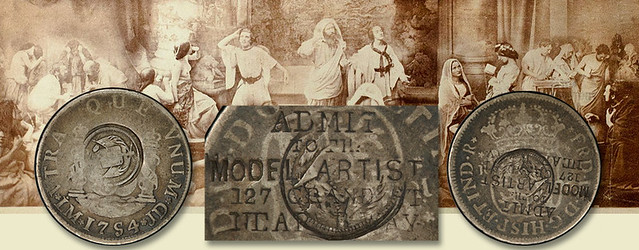
PREV ARTICLE
NEXT ARTICLE
FULL ISSUE
PREV FULL ISSUE
TRIPLE COUNTERMARKED COIN EXAMINEDStack's Bowers Senior Numismatist and Cataloger Jeremy Bostwick published a blog article this week on an interesting counterstamped piece in the Matthew Orsini Collection to be offered by the firm in January 2021. -Editor

Countermarks have long served in the role of "repurposed numismatics," with a host coin issued under the auspices of one authority being appropriated by another sometime down the road. The concept of repurposing coins is not new, and often involves the melting down of a coinage seized, for example, during a war and then giving it new life when re-coined. Such production need not be so ambitious, however, as the original coin can, rather more conveniently, be altered simply with a stamp that conveys the new authority or usage while not attempting to hide the coin's original issuer or purpose. As there would sometimes be no clear connection between host and subsequent countermark, this field of collecting creates some rather unusual pairings and historical blending on the same piece. Nowhere is this more the case than a particularly extraordinary and unique 18th century silver issue that is featured in the Matthew Orsini Collection to be offered in January 2021. Struck in the Peruvian capital city of Lima in 1754, this well circulated 2 Reales presents not one, but three different countermarks, with each chronicling the host's travels throughout the western hemisphere. The first, placed inverted over the crowned coat-of-arms, was applied for the Franklin Museum, an establishment owned by George Lea and in operation just off Broadway in New York City during the mid-late 1850s. The countermark rather clearly shows the trajectory of this South American piece, placing it in the bustling heart of the United States a century after it was minted. Further, the Mint Act of 1857 demonetized foreign issues in domestic transactions, which could account for it gaining this "second life" as an establishment ticket. Or, it could account for it entering its "third act," moving southward again to Central America. This return voyage to Latin America is evident upon the shield side, with a 'type V' El Salvadoran countermark -- directly across the Franklin Museum stamping -- signifying that it was an approved coin of the realm as of 1868. Quite interestingly, a third countermark on the pillars side adds a final, and entirely superfluous, footnote. Intended for British coins to further legitimatize them in El Salvador, this countermark serves no actual purpose, as the host coin is clearly from Latin America. The only explanation is that someone unfamiliar with English merely saw the English-reading countermark of George Lea, assumed that the coin was British, and "validated" it with the 'type VII' countermark. There would otherwise be no need for this final marking. Circling back to the focus of the initial countermark, the Franklin Museum acted not as an erudite, academic institution as the "museum" moniker would imply, but rather as a more adult-themed venue for the entertainment of men. Calling their offerings tableaux vivants lent a more high-brow façade, however these establishments were home to shows that acted as forerunners to burlesque shows. Performances featured semi-nude and even fully-nude women in various artistic plays, allowing the acts to pass, at least prima facia, as wholesome, even if, in reality, they merely served to titillate their audience. Admission started at 25 cents for a box seat, with prices rising for closer or more private seating. Given the denomination of the present countermarked piece, the 2 Reales was equivalent to a quarter, likely meaning that this pass admitted the bearer to one of the box seats. It is easy to see that the present unique offering would have countless stories to offer if only it could talk.
To read the complete article, see:
THE BOOK BAZARREWayne Homren, Editor The Numismatic Bibliomania Society is a non-profit organization promoting numismatic literature. See our web site at coinbooks.org. To submit items for publication in The E-Sylum, write to the Editor at this address: whomren@gmail.com To subscribe go to: https://my.binhost.com/lists/listinfo/esylum All Rights Reserved. NBS Home Page Contact the NBS webmaster 
|